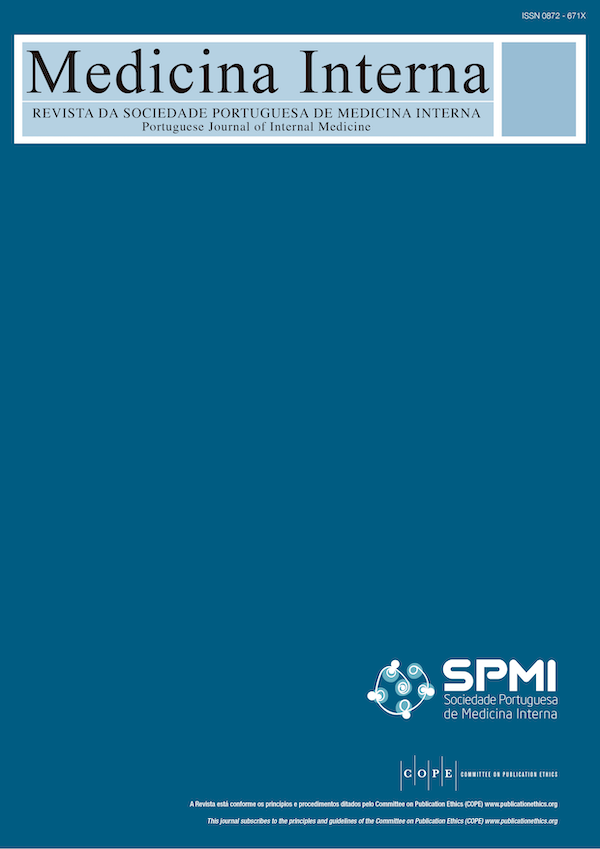Biologics Drugs in Behçet’s Disease: A Single Centre Experience
DOI:
https://doi.org/10.24950/rspmi.o.13.4.2021Abstract
Introduction: Behçet´s disease (BD) is a systemic vasculitis of unknown cause. Several cytokines, such as tumor necrosis factor-alpha (TNF-α), appear to play a substantial role. Therefore, biologics such as anti-TNF-α agents are rising to control severe or refractory BD´s manifestations.
We aimed to describe the biological therapy´s outcomes in BD patients.
Methods: A longitudinal, prospective, unicentric cohort study with patients followed in a specialized outpatient clinic. We collected data regarding BD´s manifestations, treatments, and outcomes during follow-up.
Results: Our cohort includes 243 patients, of whom 31% were male. During follow-up, 20 patients (8%) were treated with biological drugs. Patients who received biological therapies were younger (p = 0.030), had less frequently genital aphthosis (p = 0.009), and more frequently erythema nodosum (p = 0.009), polyarthritis (p = 0.002), spondyloarthritis (p = 0.024), retinal vasculitis (p = 0.011) and gastrointestinal manifestations (p = 0.024), namely gastroduodenal ulcer (p = 0.035), digestive bleeding from ulcers (p = 0.002), and bowel perforation (p = 0.004). Anti-TNF-α agents were used in all of these patients, most frequently infliximab. Patients started biologicals after classical immunosuppressors failure, and most went into remission (93%). Three patients developed tuberculosis during treatment, regardless of regular screening tests. It was possible to stop biological therapy in five patients, so far, without recurrence, with 33 months of mean follow-up time after suspension.
Discussion: Anti-TNF-α agents are highly effective for refractory BD´s manifestations, although they are not innocuous. Little is known about the optimal duration of these therapies, regarding when and how to stop these drugs. This issue is essential not only to avoid relapses but also to reduce therapy side-effects.
Downloads
References
Behçet H. Uber rezidivierende, apthöse durch ein Virus verursachte Geschwüre am Mund, am Auge und an den Genitalien. Dermatol Wochenschr. 1937;36:1152-57.
Jennette JC, Falk RJ, Bacon PA, Basu N, Cid MC, Ferrario F,et al. 2012 revised International Chapel Hill Consensus Conference Nomenclature of Vasculitides. Arthritis Rheum. 2013;65:1-11. doi: 10.1002/art.37715.
Alpsoy E. Behcet´s disease: A comprehensive review with a focus on epidemiology, etiology and clinical features, and management of mucocutaneous lesions. J Dermatol. 2016;43:620-32. doi: 10.1111/1346-8138.13381.
Davatchi F. Behcet´s disease. Int J Rheum Dis. 2018;21:2057-8.
Akkoc N. Update on the epidemiology, risk factors and disease outcomes of Behcet´s disease. Best Pract Res Clin Rheumatol 2018;32:261-70.
Piga M, Mathieu A. Genetic susceptibility to Behcet´s disease: role of genes belonging to the MHC region. Rheumatology. 2011;50:299-310.
Crespo J. Grupo Nacional para o Estudo da Doença de Behçet. Doença de Behçet – Casuística nacional. Med Intern. 1997;4:225-32.
Davatchi F, Chams-Davatchi C, Shams H, Shahram F, Nadji A, Akhlaghi M, et al. Behcet´s disease: epidemiology, clinical manifestations, and diagnosis. Expert Rev Clin Immunol. 2017;13:57-65. doi: 10.1080/1744666X.2016.1205486
Evereklioglu C. Current concepts in the etiology and treatment of Behcet disease. Surv Ophthalmol 2005;50:297-350.
Piga M, Mathieu A. The origin of Behcet´s disease geoepidemiology: possible role of a dual microbial-driven genetic selection. Clin Exp Rheumatol. 2014;32:S123-9.
Kallel A, Ben Salem T, Hammami MB, Said F, Jemaa R, Houman MH, et al. Association of systemic beta-defensin-1 and -20G/A DEFB1 gene polymorphism with Behcet´s disease. Eur J Intern Med. 2019;65:58-62. doi: 10.1016/j.ejim.2019.02.008.
Park UC, Kim TW, Yu HG. Immunopathogenesis of ocular Behcet´s disease. J Immunol Res. 2014;2014:653539. doi: 10.1155/2014/653539.
Tong B, Liu X, Xiao J, Su G. Immunopathogenesis of Behcet´s Disease. Front Immunol. 2019;10:665. doi: 10.3389/fimmu.2019.00665.
Sfikakis PP, Theodossiadis PG, Katsiari CG, Kaklamanis P, Markomichelakis NN. Effect of infliximab on sight-threatening panuveitis in Behcet´s disease. Lancet. 2001;358:295-6. doi: 10.1016/s0140-6736(01)05497-6.
Yazici H, Seyahi E, Hatemi G, Yazici Y. Behcet syndrome: a contemporary view. Nat Rev Rheumatol. 2018;14:107-19. doi: 10.1038/nrrheum.2017.208.
Hatemi G, Seyahi E, Fresko I, Talarico R, Hamuryudan V. One year in review 2019: Behcet´s syndrome. Clin Exp Rheumatol. 2019;37 Suppl 121:3-17.
Criteria for diagnosis of Behcets disease. International Study Group for Behcet´s Disease. Lancet. 1990;335:1078-80.
Vitale A, Rigante D, Lopalco G, Emmi G, Bianco MT, Galeazzi M, et al. New therapeutic solutions for Behcet´s syndrome. Expert Opin Investig Drugs 2016;25:827-40. doi: 10.1080/13543784.2016.1181751.
Alibaz-Oner F, Sawalha AH, Direskeneli H. Management of Behcet´s disease. Curr Opin Rheumatol. 2018;30:238-42. doi: 10.1097/BOR.0000000000000497.
Sfikakis PP, Arida A, Ladas DS, Markomichelakis N. Induction of ocular Behcet´s disease remission after short-term treatment with infliximab: a case series of 11 patients with a follow-up from 4 to 16 years. Clin Exp Rheumatol. 2019;37 Suppl 121:137-41.
Magro-Checa C, Salvatierra J, Rosales-Alexander JL, Orgaz-Molina J, Raya-Alvarez E. Life-threatening vasculo-Behcet following discontinuation of infliximab after three years of complete remission. Clin Exp Rheumatol. 2013;31:96-8.
Borekci S, Atahan E, Demir Yilmaz D, Mazıcan N, Duman B, Ozguler Y, et al. Factors affecting the tuberculosis risk in patients receiving anti-tumor necrosis factor-alpha treatment. Respiration. 2015;90:191-8. doi: 10.1159/000434684.
Algood HM, Lin PL, Flynn JL. Tumor necrosis factor and chemokine interactions in the formation and maintenance of granulomas in tuberculosis. Clin Infect Dis. 2005;41 Suppl 3:S189-93.
Programa Nacional para a Tuberculose. Manual de Tuberculose e Micobactérias não tuberculosas. Lisboa: Direção-Geral da Saúde; 2020.
Downloads
Published
How to Cite
Issue
Section
License
Copyright (c) 2021 Medicina Interna

This work is licensed under a Creative Commons Attribution 4.0 International License.
Copyright (c) 2023 Medicina Interna






